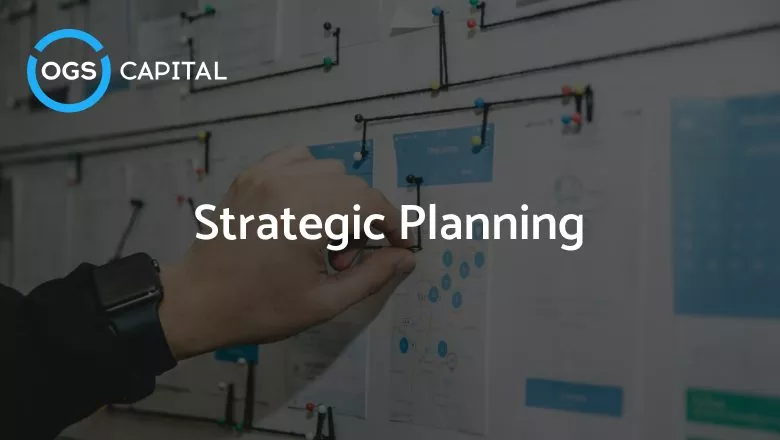Table of Content
What Is Strategic Planning in Business?
Strategic planning in business is a way of making a path for your company’s future. It assists in determining goals, creating tactics, measuring progress and making adjustments.This process is vital because it gives you a clear direction and helps an organization use its resources effectively.
Operational and strategic planning services enables an organization to:
- Understand its customers’ needs and expectations
- Identify its strengths, weaknesses, opportunities, and threats (SWOT analysis)
- Assess its core competencies and distinctive capabilities
- Define its value proposition and differentiation strategy
- Select its target markets and segments
- Develop its product/service portfolio and pricing strategy
- Establish its distribution channels and promotional strategy
- Align its organizational structure, culture, and processes with its strategy
- Implement, monitor, and control its strategic initiatives
The Strategic Planning Process: A Step-by-Step Guide
The organizational strategic planning process requires considerable thought by the company’s upper-level management. The process is different for different organizations, depending on how big, what kind, and how complex they are, but it usually has these steps:
What Is the First Step in the Strategic Planning Process?
Establishing the Scope and Purpose is the first step. This means you need to state what the organization wants to be in the future (vision), why it exists (mission), what it stands for (values), and what it wants to accomplish (objectives). You also need to specify how long it will last and what it will cover (time frame and scope).
What Is the Second Step in the Strategic Planning Process?
Conducting a Situational Analysis is the second step. Collect and analyze relevant data and information about the organization’s internal and external environment. A common tool for this step is the SWOT analysis, which identifies the organization’s strengths, weaknesses, opportunities, and threats.
What Is the Third Step in the Strategic Planning Process?
Identifying the Strategic Issues, Goals, and Objectives is the third step. Prioritize the most critical and urgent issues and challenges the organization faces and set the long-term and short-term goals and objectives that address them. The goals and objectives should be SMART: specific, measurable, achievable, relevant, and time-bound.
What Is the Fourth Step in the Strategic Planning Process?
Formulating the Strategies, Tactics, and Action Roadmaps is the fourth step. Develop and select the best courses of action that will help the organization achieve its goals and objectives. The strategies are the general approaches and directions, the tactics are the specific methods and techniques, and the action roadmaps are the detailed steps and tasks, along with the responsibilities, resources, timelines, and indicators of success.
What Is the Fifth Step in the Strategic Planning Process?
Operational and Strategic Planning
Implementing, Monitoring, and Evaluating is the fifth step. Execute the actions, track the progress and performance, and measure the results and outcomes. The implementation, monitoring, and evaluation should depend on the indicators of success, such as key performance indicators (KPIs), metrics, and milestones. Use the feedback and learning from this step to improve and adjust the goals as needed.
What Is the Sixth Step in the Strategic Planning Process?
Reviewing and Revising the Plan Regularly is the sixth step. Conduct a periodic and comprehensive review and make the necessary changes and updates based on the changing environment and circumstances. The review and revision should also involve input and feedback from the relevant stakeholders, such as the management, staff, customers, partners, and others.
What Is the Importance of Strategic Planning
Strategic planning is crucial for the success of any organization. A study by Harvard Business School found that 48% of leaders spent less than one day per month on strategy discussion. These organizations failed to meet at least half of their targets. This shows how vital it is to devote enough time and attention to developing a strategic map, as it can make or break the success of an organization.
Purpose of Strategic Planning
The main reason for strategic planning is to establish a clear direction for the organization. It brings together efforts and resources to achieve the company’s vision and mission. It acts as a guide, helping with decision-making, allocating resources, and operational planning – making sure these activities contribute to the organization’s long-term objectives.
Goals of Strategic Planning
Strategic planning sets specific, measurable, achievable, relevant, and time-bound (SMART) goals and objectives for the organization. SMART goals are the foundation for developing tactics and roadmaps, enabling the organization to focus on achieving desired results.
Value of Strategic Planning
Strategic planning provides significant value to organizations by:
- Facilitating decision-making
- Guiding choices toward achieving common goals
- Enhancing performance
- Improving resource allocation efficiency
- Anticipating and responding proactively to changes, challenges, and opportunities
- Fostering collaboration and communication across the organization
- Providing a framework for organizational growth and sustainability
Who Does Strategic Planning in Business?
Strategic planning in business typically involves various stakeholders, each with distinct roles and responsibilities:
Board of Directors
Role: The board of directors serves as the guardians of the organization, providing oversight and guidance for the overall process.
Responsibilities:
- Establish the organization’s vision, mission, and values
- Provide tactical direction and approve the overall decisions
- Monitor the implementation and progress of the decisions
- Ensure alignment between the strategies and the organization’s purpose
Senior Management
Role: Senior managers, including the CEO, president, and executive team, lead and drive the strategic planning process within the organization.
Responsibilities:
- Develop and facilitate the planning process
- Analyze the internal and external environment to identify opportunities and threats
- Define goals, objectives, and tactics
- Ensure effective communication and alignment across the organization
- Allocate resources and monitor the implementation of the overall plan
Middle Management
Role: Middle managers act as a bridge between senior management and frontline employees, providing operational insights and ensuring the execution of the tactics within their respective departments or units.
Responsibilities:
- Contribute to the process by sharing operational knowledge and experience – Refer to our operational vs strategic section to learn more
- Translate the plan into actionable initiatives and goals for their departments
- Align departmental goals and activities with the overall goals and direction
- Implement and monitor the execution of the plan within their areas of responsibility
Employees
Role: Employees across various levels and functions contribute to the process by providing insights, feedback, and support for the organization’s strategic direction.
Responsibilities:
- Participate in focus groups, surveys, or feedback sessions to share their perspectives
- Understand and align their efforts with the organization’s goals
- Support the implementation of the decisions through their day-to-day work and activities
External Consultants or Advisors
Role: External consultants or advisors bring objective expertise and insights to enhance the process and offer guidance to the organization.
Responsibilities:
- Facilitate planning sessions and discussions
- Offer industry knowledge, best practices, and benchmarking
- Provide an external perspective to challenge assumptions and identify blind spots
- Advise on methodologies and tools to enhance the quality of the decisions
What Is Strategic Management?
Strategic management is a comprehensive and systematic approach to:
- Setting organizational goals
- Developing tactics to achieve them
- Implementing those tactics
- Assessing the results of the actions in reaching the desired outcomes.
Strategic management is an ongoing process. It allows an organization to match their resources and capabilities with their vision and deal with emerging issues and opportunities.
Strategic planning management involves several key activities:
- Strategic Analysis: This involves assessing the organization’s internal strengths and weaknesses, as well as external opportunities and threats (often referred to as a SWOT analysis). It helps in determining the organization’s competitive advantages and core competencies.
- Strategic Planning: Based on the strategic analysis, the organization develops a plan. As we discussed before, the main focus should be on understanding the current situation, setting the vision and mission, making goals and objectives, and creating strategies.
- Strategy Implementation: After the plan is ready, the organization has to put the strategies and initiatives into action. This means using resources, giving roles, and doing the necessary actions to reach the goals and objectives.
- Strategy Evaluation: It is very important to check and evaluate how the plan is going. This means measuring key performance indicators, seeing how well the strategies and initiatives are working, and changing them as needed to fit the situation.
- Strategy Revision: Based on the evaluation results, organizations might have to change their tactics, goals, or actions to match the organization’s vision and mission or to solve any problems or challenges found during the evaluation.
Strategic management planning is closely related to strategic planning but is more comprehensive and dynamic. This table highlights the key difference between these terms:
| Aspect | Strategic Planning | Strategic Management |
| Focus | Determining the direction and long-term goals | Implementation and execution of the tactics |
| Process | Defining the organization’s vision, mission, objectives, and developing policies | Monitoring, evaluating, and adjusting the implementation of the policies |
| Timeframe | Long-term, typically 3-5 years or more | Both short-term and long-term |
| Key Activities | Situational analysisGoal settingPolicy formulationResource allocation | Strategy implementationResource mobilizationPerformance monitoringOrganizational adaptation |
| Scope | Broad, covering the entire organization | Specific to the implementation and monitoring of tactics |
| Participants | Top-level managementStrategic teamExternal consultants | All levels of management and employees |
| Output | Strategic plan document | Successful execution of tactics |
Benefits of Strategic Planning
Strategic planning offers several benefits to an organization:
- Clarity of vision, mission, and values to align efforts
- Proactive thinking and anticipation of changes
- Efficient allocation of resources (human, financial, technological)
- Identification of priorities and measurable goals
- Culture of accountability and continuous improvement
- Evaluation of performance and adaptation to changing circumstances
- Stakeholder engagement and buy-in through collaborative process
- Foundation for decision-making and roadmap for achieving desired outcomes
Strategic planning is a crucial process for any business that wants to succeed in the long term. At OGSCapital, we understand the pivotal role strategic planning plays in driving organizational success. Our experienced consultants bring industry expertise and a proven track record to deliver comprehensive plans. We offer:
- Customized plans that suit your specific needs and goals, including those for a small business EB2 visa.
- Expert guidance and support from senior business consultants
- Access to the latest market research and data from globally recognized sources
- Assistance with tactical implementation and execution, as well as performance monitoring and evaluation
- High-quality documents that are well-written and well-designed, including a business plan for E2 visa.
With OGSCapital, you can be confident that you will get a strategic plan that will help you achieve your vision, mission, and objectives, and give you a competitive edge in your market. Hire pitch deck consultants from our team for a tailored approach to presenting your strategy. Contact us today to get started.
Frequently Asked Questions
Q. How to write a strategic plan?
To write a strategic plan: analyze the current situation, define the vision and mission, set goals and objectives, develop strategies and initiatives, create an action roadmap, and monitor and evaluate progress. This is a collaborative process involving input from various stakeholders and requires regular review and adjustment.
Q. What is the difference between strategic planning and strategy?
Strategic planning is the process of outlining specific steps and actions to achieve a defined goal or objective. Planning focuses on the how and involves detailed tasks and timelines. Strategy is the broader approach used to accomplish long-term objectives. Strategy focuses on the what and involves choosing the best option among various alternatives.
OGSCapital’s team has assisted thousands of entrepreneurs with top-rated document, consultancy and analysis. They’ve helped thousands of SME owners secure more than $1.5 billion in funding, and they can do the same for you.













